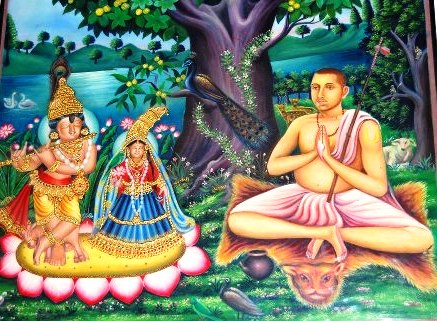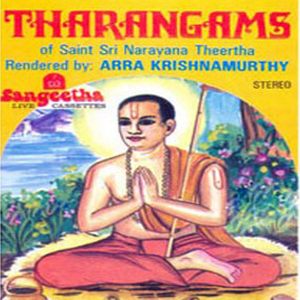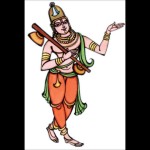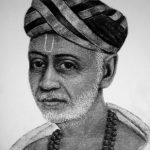From last week’s look at Telugu playback music, we come back this week to Classical Carnatic Music, and the great Andhra Personality and Telugu Saint: Sri Narayana Teertha.
A gem of a composer and spiritual figure, he is oft-forgotten amidst the famous Annamacharya, Ramadasu & Thygaraja, but is a must-know for any culturally-aware Telugu.
Background
One of the outstanding devotees of Sri Krishna, Narayana Teertha (1650- 1745 C.E.) made his name through compositions dedicated to his Ishta Devata. Appropriately, many consider him to be the reincarnation of Maharishi Veda Vyasa. But before he became the saint we know him as today, he was known by another name.
Born Tallavajjhala, Govinda Sastri to Telugu parents from Kaja village (Krishna district), he was a studious boy who grasped the Vedic literature, the Puranas, the six Sastras, and the Srimad Bhagavatam very early on. He was a mighty scholar of Sanskrit and Sangeeta (music). It is said that every significant event in his life had the hand of Lord Krishna guiding it. Indeed, one story in particular is indicative of it. Though married to a young lady named Uchamma, and preferring Grihasthashrama to the life of a sanyaasi, the Will of the Divine had other plans for him:
Once, he was on his way to his wife’s house. He had to cross the Krishna and was caught in the floods. Apprehending that his end was near, he removed his sacred thread, pulled out a hair as a token of having shaved off his head, chanted the appropriate mantra and took “apat sanyasa.”
The current, however, dragged him into a bush and he was saved. He reached his wife’s house and Uchamma, who opened the door, found a radiant sanyasi standing before her! Govinda Sastri realised that although he wanted to suppress the `apat sanyasa’ episode, it was divine will that he should become an ascetic. He retired to a lonely hill nearby and performed penance (tapas) for over a decade. [2]
Despite the intensity of his desire to stay as a husband and the later concentration of his tapas, he was not yet able to attain enlightenment. He therefore went to Varanasi and engaged in higher study. Taking the sanyaasin Sivaramananda as his guru, he was exhorted to deeply engross himself in understanding the Advaita Vedanta works of Sri Adi Sankaracharya. His philosophical mastery aside, he always had a strong calling for music.
Returning to Tirupati via Prayaga, Mathura, Puri, Mangalagiri, and Kuchipudi, he experienced Lord Krishna’s Leela in person. He came across a young boy who encouraged him to take prasadam, teasing him that he would get a stomach ache if he did not. Narayana Teertha in fact did, with the lad then laughing and dancing before later disappearing. At that moment, he realised his true purpose in life and is said to have composed the song Bala gopala mammudara right there and then.
He later read the writing on Nama-siddhantha by Sri Bodendra Sarasvati. Understanding the importance of nama-japa (chanting the names of God), he composed the gitam Rama, Krishna, Govindeti. His innate spirituality then led him to Bhupathirajapuram, colloquially called Varahur, and by Divine inspiration, helped raise a temple dedicated to Goddess Lakshmi and Lord Venkateshvara. His gitams and gadyams (prose writing) were primarily written in chaste Sanskrit. His greatest composition was Sri Krishna Leela Tarangini, a collection of wonderful songs that enraptured the village folk of Varahur, who assembled before the temple. They depicted Krishna’s life leading up to his marriage to Rukmini.
Though he spent much time in his native Andhra, including Srikakulam, Sobanadri, Venkatadri, and an agraharam in Godavari district, he found his spiritual home in Tamil Nadu. Throughout his later life Narayana Teertha came to love the beauty ofTirupoonthuruthi and enjoyed walking along the banks of the river Kaveri.
Achievements
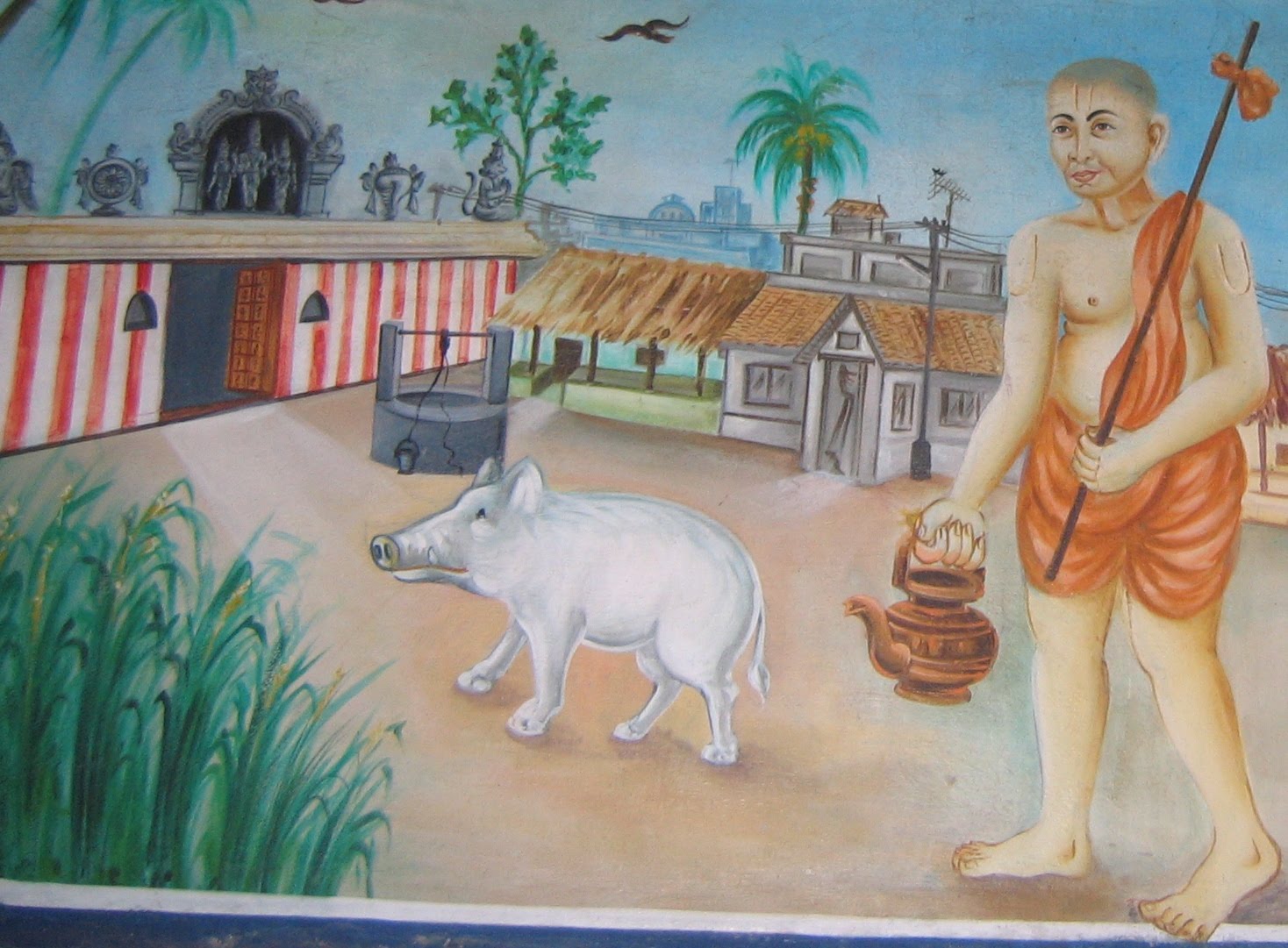
While his devotion inspires us to this day, Sri Narayana Teertha has a long list of accomplishments to his credit. He is, however, best known for popularising the Tarangam musical form, which was spread by one of his disciples, who was a gifted dancer.
- He was associated with the Bhagavata Mela tradition and composed a dance drama called Parijathe Apaharanam, a Telugu work completed at Melattur.
- A master of music, his compositional abilities were steeped in his mastery of the Natya Sastra.
- Credited with completing over 287 compositions over the course of his long life (153 in the Tarangini alone).
- Used 34 ragas for his various compositions, such as Hindolam for Govardhana and Bilahari for Puraya mama kamam
-
Composed Subhodini, a Sanskrit treatise on Brahma Sutra Sankara Bhasyam;Vivarana Deepika, a Telugu treatise on Sureshvaracharya’s Pancheekarana vartika; and the notable yakshaganam in Telugu, Parijatapaharanam.
- “Sree Krishna Leela Tarangini, his magnum opus is an unparalleled musical treatise consisting many Slokas and Krutis in 12 chapters known as Tarangas. These compositions, famous for lyrical richness and beauty of rhythm, evoke the nine ‘Rasas’ and form an integral part of Indian classical dance.” [3]
Legacy
Along with Jayadeva (of Gita Govinda fame), Narayana Teertha is considered today one of the great musical exponents of spiritual and devotional ecstasy. While there is the Sri Narayana Teertha Trust of Kaja, situated 15 kms away from Vijayawada, the famous singer Yesudas is one of the Trustees for the sister trust at Tirupoonthuruthi. In fact, he produced a serial on Narayana Teertha through Chennai Doordarshan, and has been one of the tireless exponents of this Telugu saint’s legacy. M.S. Subbulakshmi herself performed in Narayana Teertha’s honour at the inauguration of his Tamil Nadu trust.
With his most famous compositions being the timeless Govardhana Giridhara, Puraya Mama kamam, and Govindamiha, Sri Narayana Teertha is required study for self-respecting Telugus. He is virtually identified with the Tarangam form due to his masterpiece, Sri Krishna Leela Tarangini. His compositions colour the Carnatic world even today, being part of the standard repertoire of notables such as our own Andhraites, the Malladi Brothers (of Vijayawada) and Padma Vibhushan Balamurali Krishna gaaru. He remains a hidden treasure and one of the great Personalities of the Telugu people.
https://www.youtube.com/watch?v=f7hTIlkT844&list=PL70H_cAceUwrsE5f8GGSkXl2TkPd3Bx7O
References:
- http://www.carnatica.net/composer/narayanateertha.htm
- http://www.thehindu.com/fr/2005/02/04/stories/2005020400380300.htm
- http://www.sangeetasudha.org/narayanateertha/index.html
- http://www.sankeertanam.com/saints%20texts/Sri%20NarAyaNa%20Teertha.pdf
- http://www.thehindu.com/thehindu/fr/2003/03/07/stories/2003030701160600.htm
- http://www.thehindu.com/todays-paper/tp-features/tp-fridayreview/narayana-tirtha-jayanti/article1434935.ece
- http://www.thehindu.com/todays-paper/tp-features/tp-fridayreview/tharangam-in-tirtha-tradition/article658411.ece
- http://music.karthiksankar.com/reference/composer/n/narayana-tirtha/
- http://translationsofsomesongsofcarnticmusic.blogspot.com/2014/03/govardhana-giridhara-govinda.html

